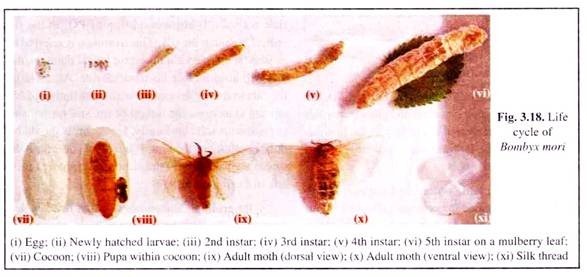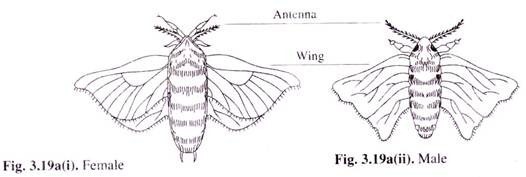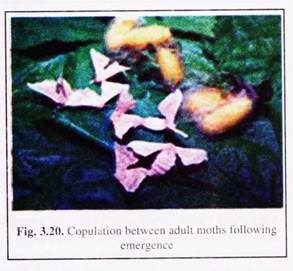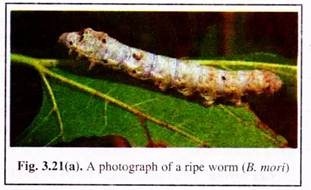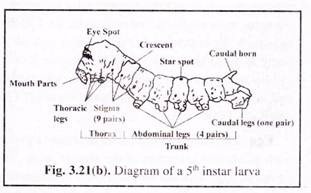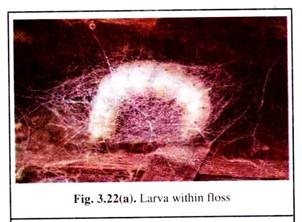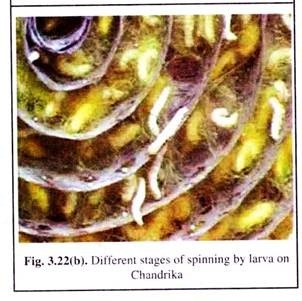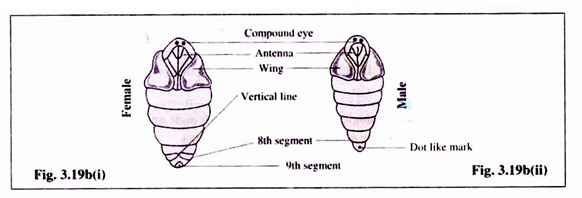In this article we will discuss about the biology and life cycle of bombyx mori.
Biology of Bombyx Mori:
The mulberry silk moth, Bombyx mori belongs to the family Bombycidae. China is the native place of this moth, but now it is totally domesticated and successfully reared in India, Japan, Korea, Italy, France and Russia. In India 92% of country’s silk production comes from mulberry moth.
The worm or larva of this moth solely feeds on leaves of mulberry plant, so named as, mulberry worm. Its wild ancestor B.mandarina still occurs in some isolated areas of Himalaya’s foothill.
Life Cycle of Bombyx Mori :
Bombyx mori being a holometabolous insect, undergoes complete metamorphosis with four stages in its life cycle, viz., egg, larva, pupa and adult (Fig. 3.18). Sexual dimorphism is present in adult, pupal and larval stages of life cycle (Fig. 3.19a, b, c).
The duration of each stage varies according to inherited characters of the race and also with the available environmental conditions, quality of food provided, etc. Here, the life cycle of most prevailed race of Bombyx mori in India will be discussed with the following headings.
ADVERTISEMENTS:
Adult moth:
The adult Bombyx moths do not take any food and incapable to fly. Their life-span is only 3-6 days. The whole body along with wings remains covered with epidermal scales and the body is divisible into 3 parts, viz., head, thorax and abdomen.
(i) Head:
The small head bears mouth at ventral side and two prominent bipectinate and serrate antennae on two sides. Below the base of antennae, two compound eyes are present on either side of the head. Mouthparts are located between the compound eyes, which include inactive coiled proboscis.
ADVERTISEMENTS:
(ii) Thorax:
Thorax has 3 segments – prothorax, mesothorax and metathorax of which mesothorax is the largest.
Each thoracic segment bears a pair of 5-jointed legs. The meso- and metathorax bear two pairs of wings, the larger, triangular forewings remain attached to mesothorax while smaller hind-wings are attached to the metathorax. Thorax also bears spiracles.
(iii) Abdomen:
The male moth has eight abdominal segments with a pair of hooks ‘harps’ at the caudal end which help in copulation. The female has larger and fatter abdomen than that of the male which has seven segments.
A knob like projection covered with sensory hairs at the caudal end of female is present. It can secrete pheromone.
Copulation:
Following emergence from the cocoon, the females rest on the cocoon, spreading out her feeble wings and immediately begin to scent by exuding pheromone from her abdominal projection. The males being attracted by the pheromone find the female and start mating (Fig. 3.20). Thus they remain over for 12-24 hours when the females get inseminated by the male.
Egg laying:
ADVERTISEMENTS:
After mating for 12-24 hours, the pair gets separated and the female starts laying eggs while the male moths die. Most females lay 150-300 eggs over the course of 1-2 days, some can lay as many as 1000 also.
According to the race, B. mori can lay two types of eggs-diapausing or hibernating and non-diapausing or non-hibernating eggs.
Egg:
The clustered eggs always remain covered with gelatinous secretion of the female moth. The colour of eggs depends on moth-race. In diapausing eggs, the colour changes from light yellow to deep brown when they enter diapause. In non-diapausing races, the colour of eggs does not change till the development is complete.
The eggs are ovoid, spherical or ellipsoid in shape and are flat on one side (dimple) through what eggs remain attached to the substratum. The centrolecithal eggs remain covered by chorion having two layers, outer exochorion and inner endochorion. Each egg has an opening, called micropyle at the anterior end.
Hatching:
The hatching time of silk moth eggs varies with voltinism and environmental conditions. Diapausing eggs under natural conditions remain dormant for months till next spring. If diapause is broken by acid treatment, the eggs have to be incubated at a temperature of 23-25°C for 11 to 14 days for completion of embryonic development and the larvae to hatch out. Non-diapausing eggs normally take 9-12 days to hatch into larvae.
Larvae of Bombyx Mori:
The newly hatched larvae are about 3 mm long, black in colour and is covered by bristles situated on tubercles in each body segment. Young larvae soon after hatching start feeding on mulberry leaves and grow. This period is called first instar. After about 3 days, larvae stop feeding and undergo ecdysis (shading off old cuticle). This period of ecdysis is called moulting.
After moulting, the larvae start feeding again and grow rapidly in size. They repeat the moulting process usually for 4 times and thus the larvae or caterpillars get changed into second, third, fourth and fifth instar stages during the whole larval period (Fig. 3.18). It takes about 21-25 days after hatching in case of multivoltine moths or 24-48 days in case of uni- or bivoltine moths.
The fifth larval stage is the longest stage when the larvae show maximum consumption of mulberry leaves and high growth. Of the total ingestion during the entire larval period, nearly 85% is taken during 4th and 5th in stars and a larva can take mulberry leaves weighing 30,000 times of its body weight to reach 5th instar stage from 1st instar.
The full grown 5lh instar larvae are 7.5-10 cm in length. Its body is divisible into 3 parts, small head with special spinneret through which silk is exuded; thorax with 3 segments, each with a pair of clawed true legs which are not used for walking but for holding the leaves while feeding; and abdomen with 11 segments.
The 9th, 10th and 11th abdominal segments are fused together to form the apparent 9th segment, anal plate and paired caudal prolegs. Each 3rd, 4th, 5th and 6th segment bears a pair of fleshy, un-jointed muscular protuberances, known as pseudolegs or prolegs, each bearing curved hook on the outer edge of leg tip disc. The eighth abdominal segment has a projection on dorsal side, called caudal horn (Fig. 3.21a & b).
The most characteristic feature of silkworm is their silk gland which is well- differentiated in 4th and 5th instar stages (discussed elsewhere). There are nine pairs of spiracles or stigmas placed laterally on either side of the larval body. Besides this, larva has a number of projections or nodules all over the body and markings on the skin which is race-specific.
The larvae have sexual dimorphism. In female larvae, the sexual marking appears as a pair of milky white spots known as Ishiwatas’ gland, one each in the right and left sides of 8,h and 9,h abdominal segments. In male larvae, the reproductive gland appears as a small milky white protuberance at the centre of the vental side between 8th and 9th abdominal segments (Fig. 3.19c). This gland is known as Herold’s gland.
Ripe larva:
The full grown final 5th instar that has stopped feeding and ready to spin the cocoon is called ripe worm or ripe larva. This stage is attained after 6-7 days of feeding in 5th instar stage for bi- and multivoltine races in tropics and 7-9 days for uni- and bivoltine for subtropical races.
It is translucent as the gut discards all of its green content. The body of ripe worm shrinks in length and a visible constriction appears at 4th and 5th segments. The worm stops feeding and usually moves towards the edge of rearing tray.
Cocooning/spinning:
The ripe worm after being shifted to mountage passes last excreta which are red in colour due to presence of tryptophan metabolites. After emptying its gut, it first secretes a tiny droplet of silk – the anchorage spot, which hardens and sticks onto the mountage. The larva then anchors itself to that spot and spins a loose hammock forming the framework of the cocoon.
This loose, tangled mass of filament is called blaze or floss which is not reelable (Fig. 3.22a). After getting a good foothold in the hammock, the larva lays down the cocoon (Fig. 3.22b). During spinning, the larva moves its head in a typical pattern; so the filament is spun either in the shape of or a.
The former is found in the outer layer, whereas the latter type is common in middle and inner layers of cocoon. In this way, after forming a compact cocoon, the larva shrinks and covers itself with a thin layer of silk. Then it detaches itself from the shell, moults and transforms into pupa. The last layer of thin silk is called pelade layer of cocoon which is unreelable.
During spinning, the secretions from two silk glands come out through the spinneret independently as fibres and called brins. The secreted sericin of both glands cements these two brins in a single thread, called bave.
Dragging – a physical process is also responsible for the coagulation of liquid silk to the fibre. The process of spinning the cocoon takes about one to two days in case of multivoltine and two to three days in uni/bivoltine races.
Pupa of Bombyx Mori :
Once the cocoon formation is over, the larvae moult inside and transform into pupae (Fig. 3.18viii). This is known as pupation. Papal stage is also called as resting or inactive stage in the life cycle of silkmoth. Actually it is a transitional stage during which some changes take place in the body of mature larvae (ripe worms).
Before transforming into proper pupa, the mature larvae pass through a pre-pupal stage during which dissolution (histolysis) of many larval organs like silkgland, moulting gland, abdominal appendages take place.
It is followed by the formation of adult organs (histogenesis) during pupal stage when a pair of large compound eyes, a pair of large antennae, fore and hind wings, legs, etc. become prominent. The cuticle of newly formed pupa is soft and pale yellow in colour which gradually becomes darker.
In the female pupa, a fine longitudinal line joining the 8th and 9th abdominal segments is present on the ventral side. In male pupae such line is absent; instead a small opening is present in the 9th segment (Fig. 3.19b). Usually female pupae are larger and heavier than the male pupae.
The pupal stage continues about 10-12 days during which development of full grown moth is completed. The adult moth then secretes mild protease from their salivary gland to dissolve the cocoon membrane in the form of a small opening through which they emerge out.
In this way Bombyx mori completes its life cycle through the above-mentioned stages and concomitant activities.
